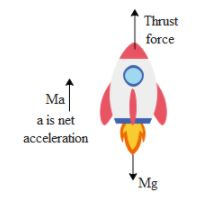
A 5000kg rocket is set for a vertical firing. The exhaust speed is 800m/s. To give an upward acceleration of $20m{{s}^{-2}}$ the amount of gas ejected per second to supply the needed thrust is ($g=10m{{s}^{-2}}$)
$\begin{align}
& a)127.5kg{{s}^{-1}} \\
& b)137.5kg{{s}^{-1}} \\
& c)187.5kg{{s}^{-1}} \\
& d)185.5kg{{s}^{-1}} \\
\end{align}$
Answer
576.9k+ views
Hint: A rocket works on the principle of law of conservation of momentum. The fuel continuously gets ejected from the rocket as a result an upward thrust is generated which helps the rocket to propel. Now we want the rocket to move with an upward acceleration of $20m{{s}^{-2}}$ which is the net acceleration. The thrust force on the rocket comprises the terms i.e. fuel ejected per unit time. Hence using the equation of net force on the rocket such that it is moving with acceleration of $20m{{s}^{-2}}$, we can calculate the gas ejected per second to supply the needed thrust.
Complete step-by-step answer:

In the above free body diagram we can see that the thrust force gives a net acceleration upwards to the rocket. The mass of the rocket is M, hence the gravitational force acts vertically downwards. Hence the equation of motion of the rocket is,
${{F}_{NET}}={{F}_{THRUST}}-{{F}_{GRAVITY}}...(1)$.
Let us say the rocket moves vertically upwards with acceleration a, hence the net force on the rocket is ${{F}_{NET}}=Ma$ The thrust force acting on the rocket is given by, ${{F}_{THRUST}}={{U}_{REL}}\dfrac{dm}{dt}$ where ${{U}_{REL}}$is the relative velocity of the rocket with respect to the ejected gas and $\dfrac{dm}{dt}$is the rate at which the fuel gets ejected from the rocket.
Let us now use equation 1 to determine the term i.e. $\dfrac{dm}{dt}$gas ejected per sec.
$\begin{align}
& {{F}_{NET}}={{F}_{THRUST}}-{{F}_{GRAVITY}} \\
& \Rightarrow Ma={{U}_{REL}}\dfrac{dm}{dt}-Mg \\
& \Rightarrow Ma+Mg={{U}_{REL}}\dfrac{dm}{dt} \\
& \Rightarrow \dfrac{dm}{dt}=\dfrac{M(a+g)}{{{U}_{REL}}} \\
& \Rightarrow \dfrac{dm}{dt}=\dfrac{5000(20+10)}{800}=\dfrac{500(3)}{8}=187.5kg{{s}^{-1}} \\
\end{align}$
So, the correct answer is “Option C”.
Note: The exhaust speed is always given relative to the rocket. The faster we accelerate the rocket more fuel has to be burnt per sec. Once the entire fuel is consumed the speed acquired by the rocket is called the burnout speed. This is the maximum speed a rocket can have and is directly proportional to the exhaust speed of the rocket.
Complete step-by-step answer:

In the above free body diagram we can see that the thrust force gives a net acceleration upwards to the rocket. The mass of the rocket is M, hence the gravitational force acts vertically downwards. Hence the equation of motion of the rocket is,
${{F}_{NET}}={{F}_{THRUST}}-{{F}_{GRAVITY}}...(1)$.
Let us say the rocket moves vertically upwards with acceleration a, hence the net force on the rocket is ${{F}_{NET}}=Ma$ The thrust force acting on the rocket is given by, ${{F}_{THRUST}}={{U}_{REL}}\dfrac{dm}{dt}$ where ${{U}_{REL}}$is the relative velocity of the rocket with respect to the ejected gas and $\dfrac{dm}{dt}$is the rate at which the fuel gets ejected from the rocket.
Let us now use equation 1 to determine the term i.e. $\dfrac{dm}{dt}$gas ejected per sec.
$\begin{align}
& {{F}_{NET}}={{F}_{THRUST}}-{{F}_{GRAVITY}} \\
& \Rightarrow Ma={{U}_{REL}}\dfrac{dm}{dt}-Mg \\
& \Rightarrow Ma+Mg={{U}_{REL}}\dfrac{dm}{dt} \\
& \Rightarrow \dfrac{dm}{dt}=\dfrac{M(a+g)}{{{U}_{REL}}} \\
& \Rightarrow \dfrac{dm}{dt}=\dfrac{5000(20+10)}{800}=\dfrac{500(3)}{8}=187.5kg{{s}^{-1}} \\
\end{align}$
So, the correct answer is “Option C”.
Note: The exhaust speed is always given relative to the rocket. The faster we accelerate the rocket more fuel has to be burnt per sec. Once the entire fuel is consumed the speed acquired by the rocket is called the burnout speed. This is the maximum speed a rocket can have and is directly proportional to the exhaust speed of the rocket.
Recently Updated Pages
Why are manures considered better than fertilizers class 11 biology CBSE

Find the coordinates of the midpoint of the line segment class 11 maths CBSE

Distinguish between static friction limiting friction class 11 physics CBSE

The Chairman of the constituent Assembly was A Jawaharlal class 11 social science CBSE

The first National Commission on Labour NCL submitted class 11 social science CBSE

Number of all subshell of n + l 7 is A 4 B 5 C 6 D class 11 chemistry CBSE

Trending doubts
What is meant by exothermic and endothermic reactions class 11 chemistry CBSE

10 examples of friction in our daily life

One Metric ton is equal to kg A 10000 B 1000 C 100 class 11 physics CBSE

1 Quintal is equal to a 110 kg b 10 kg c 100kg d 1000 class 11 physics CBSE

Difference Between Prokaryotic Cells and Eukaryotic Cells

What are Quantum numbers Explain the quantum number class 11 chemistry CBSE




